
This is the Pioneer SX-1000TD which is one of Pioneer’s first all solid state receivers. There were a couple other similar models in the SX-1000TW and SX-1000TA. I believe the TA model actually had one tube in the tuner section while the all solid state TD version was a European release and the TW was sold in the U.S. Still, it also looks like the SX-1000TD was rebadged and sold as an Allied receiver in the U.S. as well.
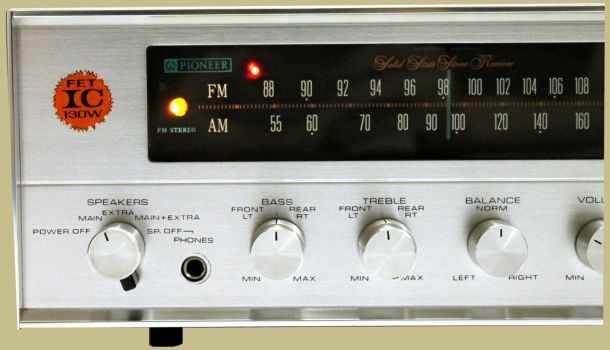
The SX-1000TD is a 50 watt per channel receiver and has a great lates 60’s vintage look to it. It measures 15 15/16″ X
13 3/4″ X 5 3/8″ and weighs roughly 23 pounds.
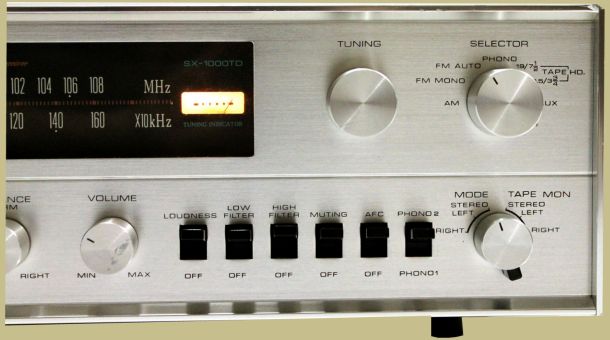
The TD and TW models look very similar on the outside. Here is the TW model in a wood case:
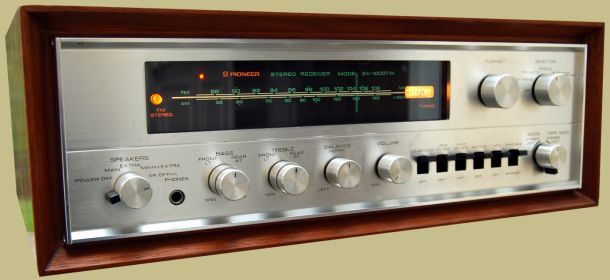
The TA version on the other hand looks very different:

As I mentioned above, the TA version has a tube in the tuner section as well as two Nuvistors which are actually tubes as well so there are really 3 tubes in the tuner section. The Nuvistors were used in some RF applications during the mid 60’s because transistors were still hard to produce and were less than reliable. So, the TA version of the SX-1000 is a hybrid design and was probably produced before the TD and TW versions. Once Pioneer decided to go all solid state they quit making the TA and switched to the TW and TD instead. Obviously they redesigned the front panel as well as some of the circuitry as well. I’m not sure of the output of the TA version. I’ve seen most quote it at 50 WPC but I’ve seen others claim it is 20 WPC.
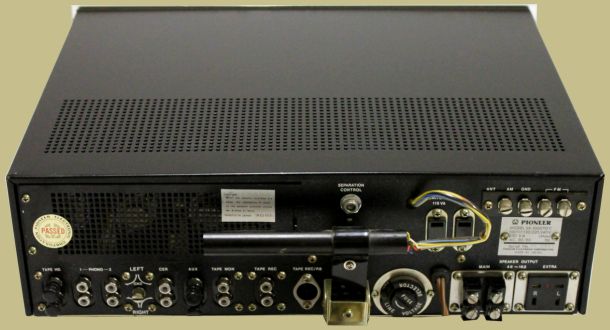
Another thing you may notice about the SX-1000 series is that they have strange speaker plugs on the back panel. The TD model shown above has an adapter plugged into the main speaker outputs. The adapters look like this:
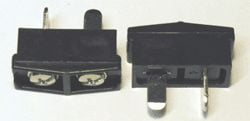
You’ll need these to hook up speakers to your SX-1000 model receiver. They can usually be found on eBay HERE.
Here is a really nice SX-1000TW in a wood case. As you can see it looks essentially identical to the TD version.
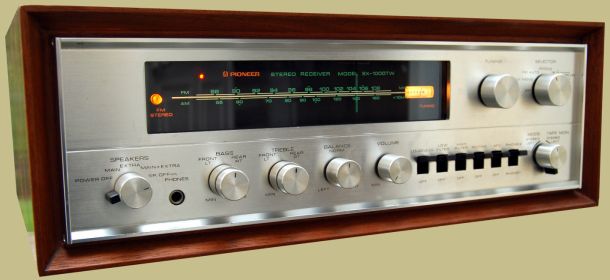
All of the Pioneer SX-1000 versions are in demand from collectors and enthusiasts. A TW version in excellent working condition will sell for around $250.00 which is about the top end for the SX-1000’s.
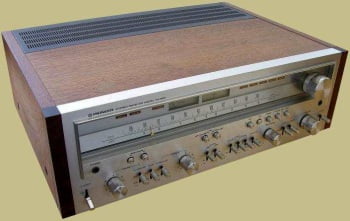

Beautiful work and writing
I just purchased a Pioneer SX-1000TW receiver and was wondering if this model had a dial lamp. My meter and signal lamp lite up however it appears that the dial doesn’t have a lite.
Hi, yes, I’ve seen pictures of the Pioneer SX-1000TW and it does have a dial lamp. I believe the bulbs are 6.3V and .25W and you can sometimes find them at radio shack or a hardware store. Just pull the old lamp out and take it with you so you can match them up.
cAN YOU HOOK UP A IPOD TO THIS RECIEVER????
Not directly. You would have to get an adapter cable that plugs into the headphone on the iPod and then splits into two RCA connectors and connects to the Aux inputs on the back of the stereo. There are other ways to do it that are even better though. Check out this thread on audiokarma.
Yes………you can hook-up a iPod to the SX-1000 receiver, but you need a iPod 4–5 base that has a audio out 3.5mm plug. I hooked up my iPod 7 to it also…..but used iPod base. Works fine.
No
Hi, great post. My grandparents just gave me this receiver with 2 speakers. Sadly it didn’t come with the adapter plugs. Is there a way to “modernize” the terminals that the speaker wires connect to in order to take RCA or something like that? Not exactly the best with vintage electronics, but wanting to learn so I can hang on to this. Thank you in advance!
The plugs can be found on eBay occasionally though they aren’t very cheap (about $20+ each). I know many have tried to make them in various ways. Probably the best idea I’ve seen, though I haven’t tried it, is to use male spade crimp terminals. They basically just plug into the plug on the back of the receiver and you crimp the speaker wire onto the other end.
Just search for “Male Spade Crimp Terminals” on ebay. Some have said they are 7.8mm connectors but I haven’t tried it so I’m not sure but I would try those first. Or, you could try to measure your terminal width to see what it is. I think 7.8mm is about 5/16 inch.
Just saw this site. Thanks guys. I have my father’s SX-1000TD/wood case in great shape he bought in Okinawa, Japan in 1969. No manuals, sales/repair receipts, box. When I hooked it up to my Dahlquist DQM-5 speakers to try it out, I just inserted the 16 gage wires into the slots. A tight fit and it sounded fine. I just measured the width of the slots with a Starrett dial caliper and got 0.187″ or 3/16″ or 4.76 mm (almost 5 mm), allowing for a little width on both sides of the slot. I’m going to look for those adaptor plugs and also the male spade crimp terminals. Where can I get an Owner’s Manual? I can’t seem to find one.
You can try HiFiEngine.com. You’ll have to register for an free account but they look to have a manual you can download for free.
Hello everybody, i have the SX-300T and the transistors is in germanium, are the same thing for the SX-1000TW or TD?
I have a Pioneer SX 1000 TA. Where can I get service for it? The FM does not work
and the volume is erratic. Thanks.
Where are you located?
Don’t short the speaker wires not even for a second or oops bye bye outputs
Oh I wanted to say I still have my Pioneer SX1000. I bought it from a Pacific Exchange catalog while I was back on base. 101st Airborne Div. Vietnam 1970. It’s 48 years old and still kicking out the jams daily. $69.00 with no tax new and shipped home from Japan. Can’t touch this!
I’d rather have a sansui
I just purchased sx-1000 Ta pioneer what is the value of this receiver now. I know they don’t make them anymore. This one was made in Japan. Can anyone tell me the value of this receiver. Thank you
I would guess maybe $150 if it’s working and in nice condition. You don’t see too many of the TA version. The TW version is most common.
Hi, I live in Egypt I am familiar with this receiver since I grew up with it being in my house when we were living in Kuwait I was only 1 year old at the time when my late dad bought it. I am interested to buy it for 200 US it its in good working order.
I just purchased a SX-1000 TD..the main difference from the TW seems to be the font on the dial readout…this thing is so beautiful in the wood case..I purchaces the receiver and 2 Mokado 3 way 12″ speakers that complete the look for $200 form a local record shop..this thing cranks pretty loud.
I’m restoring a TW now and they seem to be identical . Both where shipped set at 240v which is strange . I thought the D was for domestic and the W was for world . Nice sounding and 50 watts was a lot in ’69 . Was this the highest power receiver of the day? $300 in 1969 is over $2000 in 2019.
I have the Allied 395 version. Great receiver, have it paired with Realistic Optimus 5 speakers. I’d like to try my hand at recapping some of it, but it sounds good as it is I may just leave well enough alone :-).
I purchased an Allied 395 that was “gone over” by a tech, but for the price I paid doubt it was recapped…no matter, this baby has sounded glorious for the time I have owned her (several years) and is presently my #1. Nice warm sound, wicked hot FM section…thought I had lost her (main fuse blowing for no good reason), but my local tech got her back again with little difficulty. If I lost her I would be in depression! Radio Schaak had her listed as 55 Watts RMS @ 4 ohms.
Tengo un Pioneer ssx 1000 .pero no hay información del mismo en internet.puede que sea del 1976 , alguien tiene información
What fuse amperage would the sx1000tw likely require? Thanks much
Why would they make a reciever you have to buy special adapters for just a plug in your speakers???? Any more info available about that ????
I’ve never heard why Pioneer designed those that way. I think they only used them for a few years and in only a couple different receiver lines. It does make it easier to connect the speaker wires – just unplug, then connect the wires, then plug back in. The plugs came with the stereo when purchased new. But, over the years people lose them so you see quite a few for sale nowadays that are missing them. So, yeah, not the greatest design idea. Replacements are about $20 on eBay.
Those plugs, which seem oddball today, were standard for Pioneer receivers at the time; those you can buy today are of two types, “original” Pioneer and a standard electrical plug type. The Pioneers will fit perfectly, though after time may be somewhat loose; the “standard” electrical style will be very tight, and may not fit fully in (maybe 1/16″ to 1/8″ exposed) but will work fine.
I also have a Pioneer 525 that has been modified to use the “spring clip” type connectors, looks to be factory but is not, someone, somewhere, is selling a conversion…